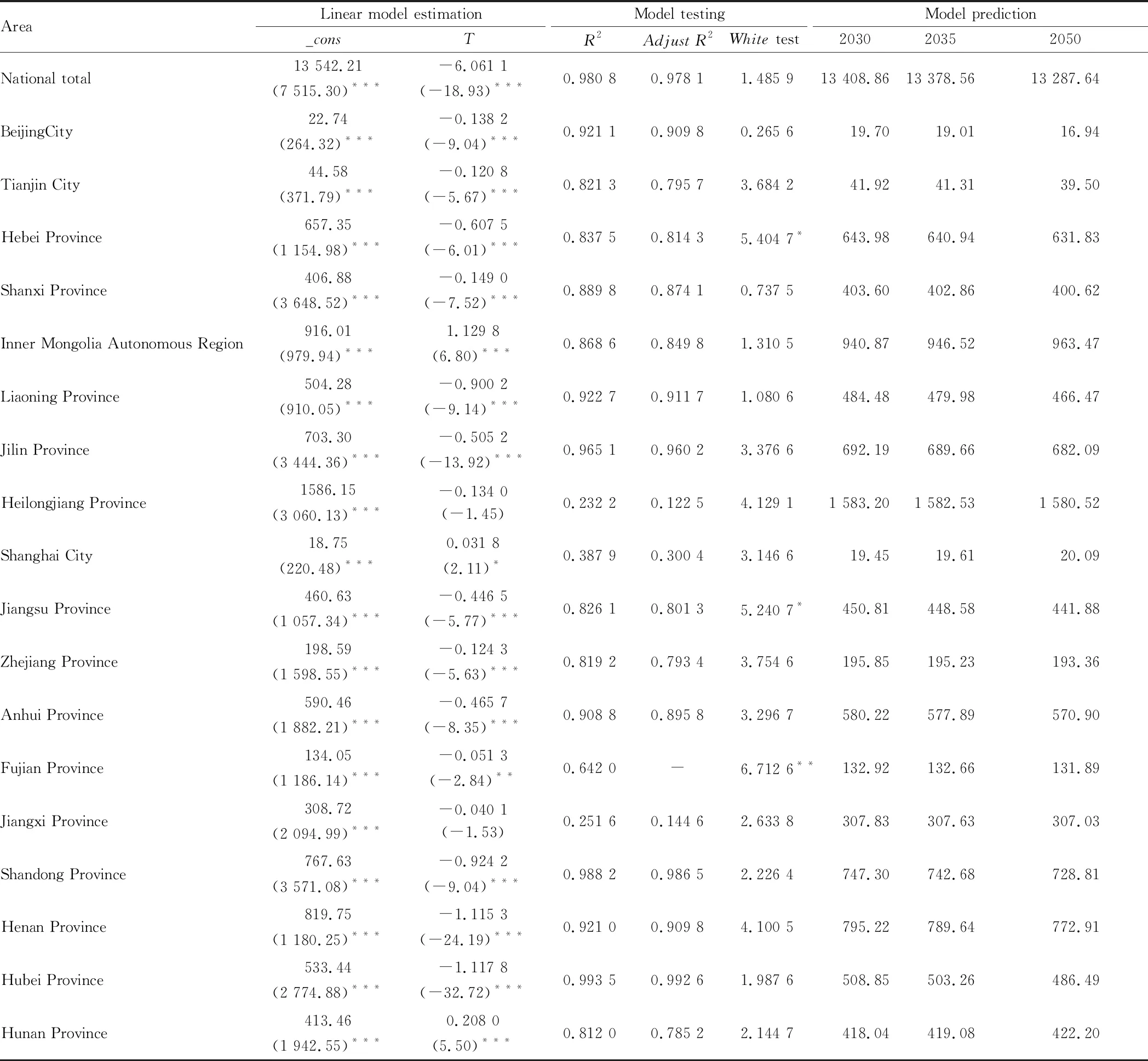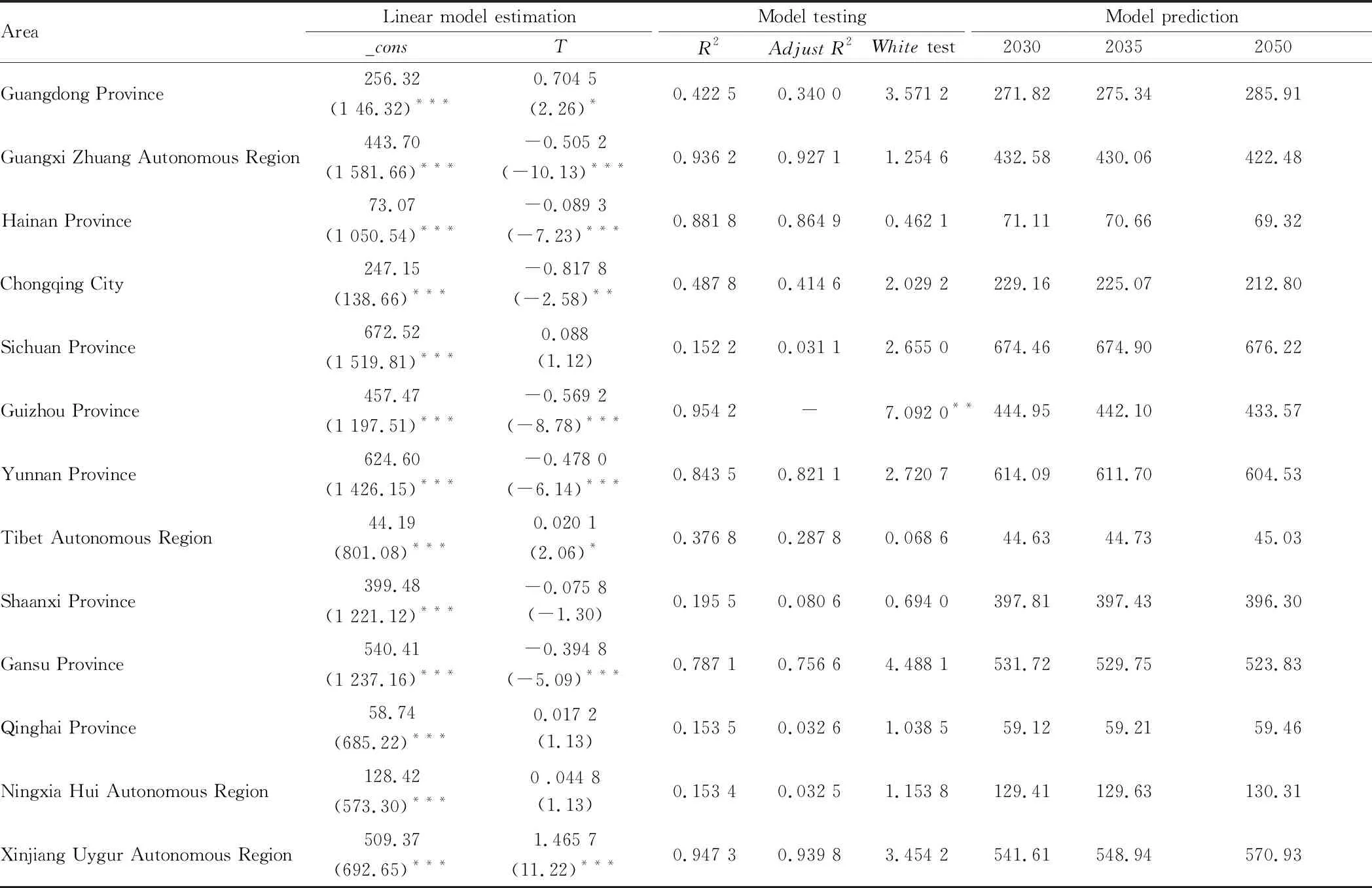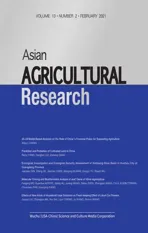Prediction and Protection of Cultivated Land in China
2021-04-08RenyiYANGFenglianLIUZishengYANG
Renyi YANG, Fenglian LIU, Zisheng YANG
Institute of Land Resources and Sustainable Development, Yunnan University of Finance and Economics, Kunming 650221, China
Abstract [Objectives] To protect cultivated land and ensure national food security and to forecast the cultivated land area of China and the provinces (cities) in 2030, 2035 and 2050. [Methods] Based on the cultivated land area data of the whole country and provinces (autonomous regions and municipalities) from 2009 to 2017, the OLS model is used to forecast the cultivated land area of China and the provinces (cities) in 2030, 2035 and 2050. [Results] The results show that the predicted area of cultivated land in 2030, 2035 and 2050 is 134.088 6, 133.785 6 and 132.876 4 million ha, respectively, showing an obvious decreasing trend. The national cultivated land scale predicted in this paper can meet the requirements of the 2030 national cultivated land retention target set in the National Land Planning Outline (2016-2030).However, in the total area of existing cultivated land, there is still a certain area of sloping cultivated land (accounting for about 4% of the total cultivated land area, it is appropriate to gradually return farmland to forest).At the same time, nearly 20% of the cultivated land has been polluted, and the low-quality cultivated land accounts for about 22% of the total cultivated land. [Conclusions] The situation of cultivated land protection in the whole country is not rosy. For this reason, some measures and suggestions are put forward: strengthening land consolidation, striving to improve the quality of cultivated land, and appropriately increasing new cultivated land; strengthening the protection of cultivated land resources and strictly controlling the reduction of cultivated land.
Key words Cultivated land, Scale, Prediction, Cultivated land protection, China, Ordinary least square (OLS) regression model
1 Introduction
Cultivated land resources are the basis of grain production. Under the circumstances of the intensification of the contradiction between human and land, the continuous reduction of cultivated land and the extreme shortage of reserve resources, one of the most basic objectives of China’s land resources strategy is to protect cultivated land and ensure national food security. Therefore, the amount of cultivated land resources has been highly valued by academia and governments at all levels. Bi Yuyunet
al
.(2000) analyzed the increase and decrease of the actual cultivated land area in the whole country since the founding of the People’s Republic of China. Feng Zhiminget
al
.(2005) analyzed the changing trend of cultivated land resources in China and reconstructed the cultivated land data from 1949 to 2003.The Outline of the Eleventh Five-Year Plan for National Economic and Social Development of the People’s Republic of China approved by the fourth session of the Tenth National People’s Congress on March 14, 2006 put forward an important binding target, that is, "the protection area of cultivated land should be maintained at 120 million ha".Yang Zisheng (2008) analyzed the necessity of ensuring the "red line" of 120 million ha of cultivated land in China, and put forward the corresponding measure system.The National Land Planning Outline (2016-2030) issued by the State Council in 2017 sets a target of 121.666 7 million ha of arable land in 2030, which is a binding target that must be achieved.In order to reveal the changes of cultivated land area in China in the next 10, 15 and 30 years and its correspondence with the national planned cultivated land retention target, based on the cultivated land area change from the second national land survey at the end of 2009 to the end of 2017, this paper uses econometric regression model to predict the cultivated land area of China and various provinces (cities) in 2030, 2035 and 2050, and then puts forward the corresponding cultivated land protection measures.2 Research methods and data sources
2.1 Prediction method of econometric regression model
According to the analysis of the change of cultivated land area of the whole country and provinces (autonomous regions and municipalities) from 2009 to 2017, this paper uses the ordinary least square (OLS) regression model to forecast the cultivated land area of China and the provinces (cities) in 2030, 2035 and 2050.The prediction method and process are as follows: the cultivated land area of 31 provinces (cities) in China from 2009 to the end of 2017 is taken as the explained variable, and the year T is taken as the explanatory variable (1 in 2009, 2 in 2010, …, 9 in 2017, and so on) to build a univariate linear regression model (OLS). Stata software is used to calculate the estimated results and test results of OLS and the predicted values of cultivated land in various provinces (cities) of China in 2030, 2035 and 2050.2.2 Data sources
The arable land area of the whole country and 31 provinces (municipalities and autonomous regions) from 2019 to 2017 is downloaded from the China Macroeconomic Database of the EPS global statistics/analysis platform. According to the database, the source of the data is China’s National Bureau of Statistics, and the data is collated by EPS DATA. Relevant land survey data over the years can also be downloaded from the website of the Ministry of Natural Resources of the People’s Republic of China (formerly the Ministry of Land and Resources).It should also be noted that the regional scope discussed and analyzed in this paper is 31 provinces (municipalities and autonomous regions) in China, excluding Taiwan, Hong Kong and Macao.
3 Prediction results and analysis
3.1 Prediction results
According to the above method, the scale of cultivated land in 2030, 2035 and 2050 of the whole country and 31 provinces (autonomous regions and municipalities) is predicted, as shown in Table 1.As can be seen from Table 1, all the constant terms of OLS have passed the significance level test of 1%; the independent variable T estimation coefficient of 22 of the 31 provinces (cities) in China has passed the significance test of 5%, which shows that the cultivated land area of these provinces (cities) changes obviously with time. Except Inner Mongolia Autonomous Region, Hunan Province and Xinjiang Uygur Autonomous Region in the 22 provinces (cities), the independent variableT
estimation coefficients of the other 19 provinces (cities) are all negative, which indicates that with the passage of time, the area of cultivated land in these provinces (cities) is showing a significant decreasing trend. In the whole country, the goodness of fit of the model (R
) is 0.980 8, the independent variableT
estimation coefficient is -6.061 1, and it has passed the 1% significance level test, indicating that the area of cultivated land in the country will be reduced by 60 611 ha for every year in the future.
Table 1 Model estimation, test and prediction results of cultivated land area in China from 2009 to 2017 104 ha

Note: *, ** and *** mean rejecting the original hypothesis at the significance level of 10%, 5% and 1%, respectively. The provinces (cities) that reject the original hypothesis in the White test at 5% significance level will be estimated by robust standard error method. The values in parentheses of the model are the estimated results of t-statistics. T represents the independent variable of year (1 in 2009, 2 in 2010, …, 9 in 2017, and so on); _cons represents the model constant.
3.2 Analysis of cultivated land scale
The statistical results show that the sum of the forecast results of the cultivated land area of all provinces (cities) in 2030, 2035 and 2050 is equal to the predicted value of total cultivated land in 2030, 2035 and 2050 in the whole country. From the overall point of view of the whole country, the predicted results of cultivated land area in 2030, 2035 and 2050 are 134.088 6, 133.785 6 and 132.876 4 million ha, respectively, showing an obvious downward trend.By contrast, the predicted area of cultivated land in 2030 (134.088 6 million ha) is 12.421 9 million ha (10.21%) more than the target of 121.666 7 million ha in 2030 set in theNational
Land
Planning
Outline
(2016-2030
). This shows that according to the changing trend of national cultivated land in the past nine years (2009-2017), the actual scale of cultivated land in 2030 in China can meet the requirements of the national cultivated land retention target set in theNational
Land
Planning
Outline
(2016-2030
).However, it should be noted that in the total area of existing cultivated land, there is still a certain area of sloping cultivated land (it is appropriate to return farmland to forest). At the same time, there is also a lot of polluted cultivated land, and low-and medium-quality cultivated land accounts for a large proportion of the total cultivated land. Therefore, the situation of cultivated land protection is not rosy. China is a mountainous country, and for a long time, deforestation and land reclamation on steep slopes are common forms of cultivated land use in mountainous areas. According to the results of the second national land survey, the area of steep slope farmland (≥ 25°) reached 5.496 million ha, accounting for 4.06% of the total cultivated land area. And the area of steep slope farmland (≥25°) in the western region reached 4.394 million ha, accounting for 79.95% of the country’s steep slope farmland. The western region is often the source and upper reaches of major rivers in China, and it is also an area inhabited by ethnic minorities. The natural conditions are poor, the level of productivity is not high, the phenomenon of predatory reclamation and extensive use of land is more prominent, the proportion of sloping farmland is high, and sloping farmland accounts for a considerable proportion. Taking the results of the second national land survey in Yunnan Province as an example, the area of sloping farmland in the province reached 61.21% (excluding terraced fields). 15°-25°sloping land (excluding 15°-25°terraced fields) and ≥25°sloping cultivated land (excluding ≥25°terraced fields) accounted for 22.87% and 12.03% of the total cultivated land in the province, respectively. The topsoil is severely disturbed by the whole process of human crop management and planting, which is very easy to produce soil and water loss. Especially after harvest of dry crops and ploughing in flood season, the amount of soil and water loss is very large due to frequent heavy rain, torrential rain and surface runoff erosion. In particular, the soil and water loss of >15°sloping farmland is extremely strong, which makes sloping farmland become the most serious type of soil and water loss in mountainous areas.
Generally speaking, at present, the problem of cultivated land pollution in China is prominent, which not only affects the output and quality of agricultural products, but also endangers the safety of human settlements.The
National
Soil
Pollution
Investigation
Bulletin
issued by the Ministry of Environmental Protection and the Ministry of Land and Resources in April 2014 showed that the percentage of national soil point exceeding standard was 16.1%, and the percentage of cultivated soil point exceeding standard was 19.4%. The percentage of mild, moderate and severe pollution points was 13.7%, 2.8%, 1.8% and 1.1%, respectively.In May 2020, the Ministry of Agriculture issued the2019
National
Cultivated
Land
Quality
Grade
Bulletin
, dividing the national cultivated land quality grade from high to low (1-10).The area of cultivated land of poor quality from grade 7 to grade 10 reached 29.6 million ha, accounting for 21.95% of the total cultivated land investigated (134.866 7 million ha).The basic fertility of this part of cultivated land is relatively poor, and the production obstacles are prominent, and it is difficult to get fundamental improvement in a short period of time, so the construction of farmland infrastructure and the internal quality of cultivated land should be carried out continuously.4 Conclusions and suggestions
4.1 Conclusions
Based on the cultivated land area data of the whole country and provinces (autonomous regions and municipalities) from 2009 to 2017, the OLS model is used to forecast the cultivated land area of China and the provinces (cities) in 2030, 2035 and 2050.The main conclusions are as follows:(i) The predicted area of cultivated land in 2030, 2035 and 2050 is 134.088 6, 133.785 6 and 132.876 4 million ha, respectively, showing an obvious decreasing trend.
(ii) The area of cultivated land in 2030 predicted in this paper is 12.421 9 million ha more than the target of cultivated land in 2030 set in theNational
Land
Planning
Outline
(2016-2030
).This shows that according to the changing trend of national cultivated land from 2009 to 2017, China’s actual cultivated land scale in 2030 can meet the requirements of the 2030 national cultivated land retention target set in theNational
Land
Planning
Outline
(2016-2030
).(iii) In the total area of existing cultivated land, there is still a certain area of sloping cultivated land (about 4% of the total cultivated land, it is appropriate to gradually return farmland to forest). At the same time, nearly 20% of the cultivated land has been polluted, and low-quality cultivated land accounts for about 22% of the total cultivated land, therefore, the situation of cultivated land protection is not rosy.
4.2 Measures and suggestions on strengthening the protection of cultivated land in China
4.2.1
Strengthening land consolidation, striving to improve the quality of cultivated land, and appropriately increasing new cultivated land. First, it is necessary to further promote land consolidation, vigorously increase the area of effective cultivated land and improve the quality of cultivated land. We should not only strengthen the consolidation of basic farmland areas, but also attach great importance to the comprehensive consolidation of sloping land in mountainous areas, so as to attach equal importance to the new cultivated land quantity, quality and ecological construction.Second, it is necessary to earnestly increase the intensity of land reclamation, strive to restore the function of abandoned land, give full play to the utilization potential of all kinds of abandoned land, increase the effective use area of cultivated land and improve land utilization rate. For land abandoned due to mine development and other reasons, it is necessary to earnestly and effectively do a good job in the reclamation of all kinds of construction wasteland by strictly abiding by the relevant provisions and requirements of theLand
Management
Law
and theProvisions
on
Land
Reclamation
, and following the principles of "whoever causes damage is responsible for reclamation". In areas with serious natural disasters, it is necessary to strengthen disaster prevention and reduction and organize the reclamation of cultivated land destroyed by disasters in a timely manner.Third, on the premise that the land ecological environment is effectively protected, it is necessary to appropriately develop the reserve resources of suitable cultivated land (that is, barren mountains, barren land, barren beaches, etc. suitable for cultivation) to ensure the balance of cultivated land occupation and compensation.
4.2.2
Strengthening the protection of cultivated land resources and strictly controlling the reduction of cultivated land. First, it is necessary to strictly control the scale of cultivated land occupied by all kinds of non-agricultural construction. On the one hand, it is necessary to further strengthen the economical and intensive use of land, and fully implement the economical and intensive land use system in all aspects of policy, planning, management, law enforcement and so on. On the other hand, it is necessary to correctly handle the relationship between construction land and cultivated land protection, strictly control the total amount of new construction land, especially the amount of cultivated land occupied, and achieve a "win-win" situation between ensuring development and protecting cultivated land. In addition, the cultivated land protection system and land use control system should be further improved, and various measures of land management should be strengthened.Second, it is necessary to strictly control the scale of agricultural restructuring and strive to ensure the long-term stability of the use of cultivated land (especially basic farmland).On the one hand, it is necessary to correctly handle the relationship between ensuring food security and developing the rural economy, scientifically control the adjustment of agricultural structure and reduce the scale of cultivated land occupied and prohibit the occupation of basic farmland to develop forest and fruit industry and to dig ponds for fish culture. On the other hand, for the cultivated land (especially basic farmland) that has been occupied and destroyed in violation of laws and regulations, measures to resume cultivation should be taken as soon as possible in accordance with state regulations.
杂志排行
Asian Agricultural Research的其它文章
- Ecological Investigation and Ecological Security Assessment of Xizhijiang River Basin in Huizhou City of Guangdong Province
- Molecular Cloning and Bioinformatics Analysis of araC Gene of Vibrio alginolyticus
- Occurrence Regularity and Integrated Control Technology of Canker in Citrus
- Activation Effect of Hydrochemical Energy in Regenerative Agriculture on Nutrients of Arsenic Sandstone
- IS-LM Model Based Analysis on the Role of China’s Financial Policy for Supporting Agriculture
- Emergy Estimation of the Main Forest Biomass in Shangri-La, Tibetan Area of Yunnan Province
